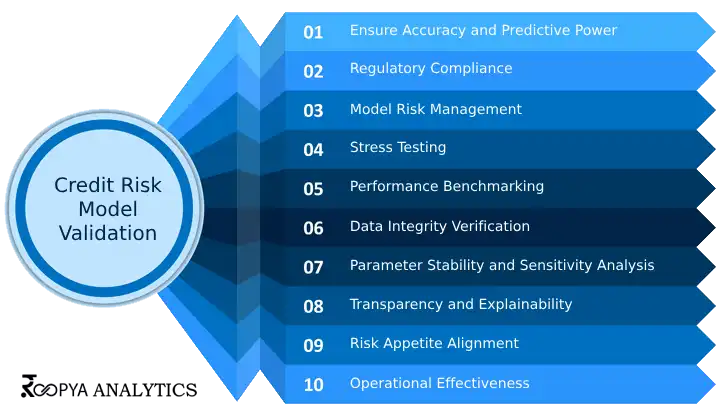| Statistical Analysis |
- Linear and logistic regression analysis
- Time series analysis
- Survival analysis
|
- Probability of Default (PD)
- Loss Given Default (LGD)
- Exposure at Default (EAD)
|
- Assess model fit (e.g., R-squared, AIC)
- Evaluate predictive power (e.g., ROC curves, AUC)
- Test for statistical significance of predictors |
| Back-testing |
- Comparison of predicted outcomes vs. actual outcomes over a historical period |
- Model performance
- Forecast accuracy |
- Use of historical loan performance data
- Analysis of model prediction errors
- Adjustment for overfitting and underfitting |
| Benchmarking |
- Comparing model outputs with those from alternative models or industry standards |
- Model competitiveness
- Model robustness |
- Selection of appropriate benchmarks
- Analysis of discrepancies and their sources
- Consideration of external factors affecting performance |
| Stress Testing |
- Scenario analysis
- Sensitivity analysis |
- Model resilience under adverse conditions |
- Design of stress scenarios (e.g., economic downturns)
- Evaluation of model outputs under stressed conditions
- Analysis of model behaviour and parameter stability |
| Sensitivity Analysis |
- Perturbation of input variables and parameters |
- Model stability
- Parameter impact |
- Identification of key drivers of model output
- Quantification of changes in output due to variations in inputs
- Assessment of parameter estimation methods |
| Data Quality Assessment |
- Data integrity checks
- Data completeness and accuracy verification |
- Input data quality
- Appropriateness for model purposes |
- Analysis of missing values and outliers
- Verification of data sources and collection methods
- Assessment of data preprocessing and feature engineering techniques |
| Model Calibration |
- Adjusting model parameters based on current and historical data |
- Model accuracy
- Parameter relevance |
- Techniques for parameter estimation (e.g., Maximum Likelihood Estimation, Bayesian approaches)
- Evaluation of calibration effectiveness |
| Regulatory Compliance Check |
- Review against regulatory guidelines and requirements |
- Compliance with regulatory standard
- Model governance and documentation |
- Documentation of model development and validation processes
- Evidence of compliance with Basel III/IV, IFRS 9, etc
- Review of model risk management practices |
| Model Use and Decision Impact |
- Analysis of model integration into business processes |
- Decision-making process
- Risk management strategy |
- Assessment of model alignment with risk appetite
- Evaluation of model's impact on lending decisions
- Review of model's operational efficiency |



